
Well, I think we’re a bit overdue for another “fakes” blog post to add to my series.
There’s an entire series of blog posts I’ve written over the years as fakes have popped up more and more.
Now, on my annual trips to the Tucson Gem & Mineral Show I get to view a lot of what’s hot on the market and also spot some of these fakes first-hand. I also like to attend some of the lectures they have at the Convention Center so I can stay up-to-the-minute and knowledgeable about what’s going on in the mineral world. Last year I audited a lecture on Fake Minerals. This year my favorite lecture was: Crystal Faces and Forms.
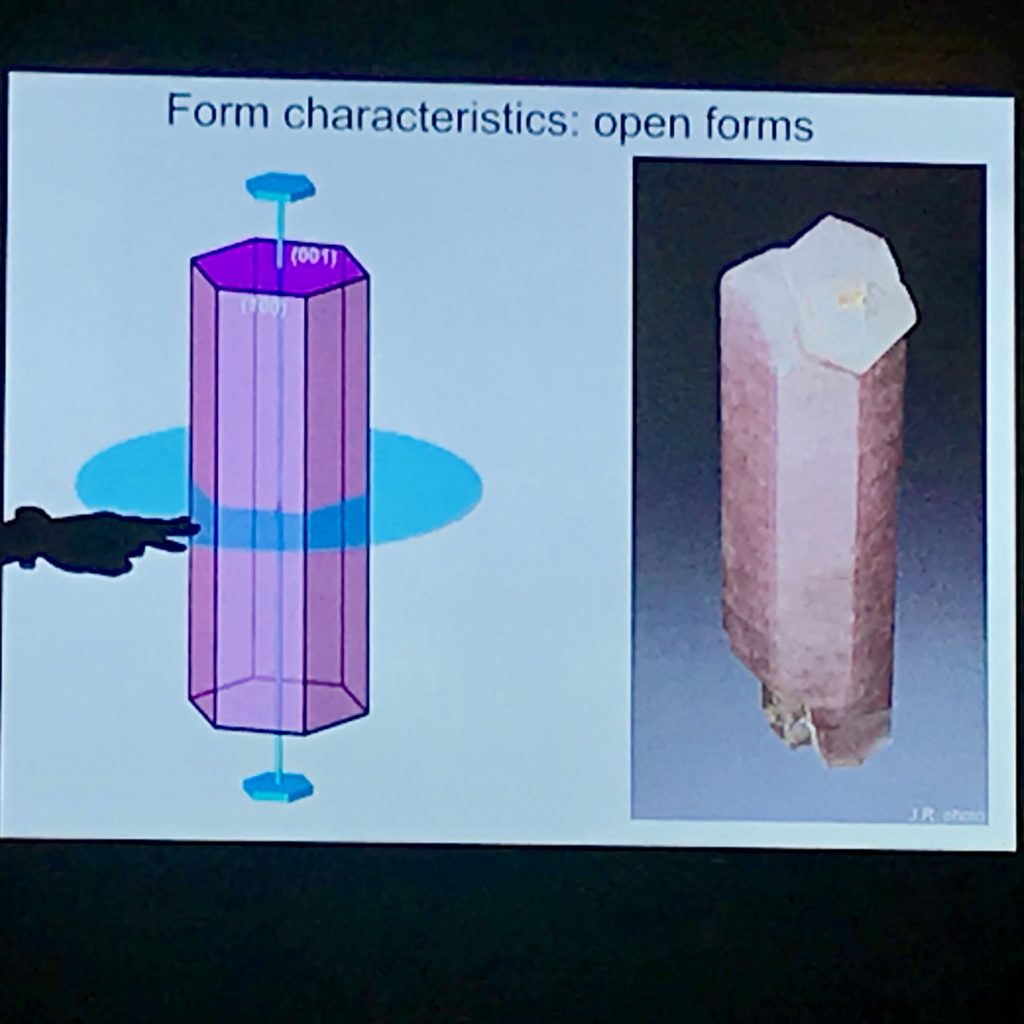
Heaven, I tell you!
Seriously. Crystal-topic academic lectures while hanging out at the biggest most glittery gem show in the world??! If you didn’t already know, I’m a HUGE Geo-Geek and yes, this is my idea of a GOOD-FLIPPIN’-TIME!
One thing that’s evident from these gemmy trips is that unfortunately, the artificial mineral/ gemstone market is on the rise.
Several years ago I noticed that there seemed to be a bit of an info-gap in our crystal community on some good solid easy-to-understand data regarding this sort of thing.
Informing our community on this topic has become a passion of mine. Being a former science department head, having studied geology at the Masters level + being an author and the founder of a Crystal Healing Academy with a relatively large following gives me a good platform to shout about crystal fakes. Right? So, I feel it’s my duty and I’m honored to be given the opportunity and privilege to serve in this way.
My goal is to educate our crystal community on what’s currently on the market so we can make intelligent buying decisions when adding special new crystal specimens to our sacred collections. If you feel passionate about this too, please share this post in any way you prefer. (There are some handy-dandy “SHARE” buttons you can use at the bottom of this post).
Keep this in mind: Always use your common sense. The best protection from crystal fakes is to be well-informed yourself.
Real vs. Fake Jade
Most jade is a beautiful soft green color (although it does come in other colors like purple, red, yellow and white). Metaphysically, it’s a gentle stone that’s perfect for abundance work and also for assisting mothers to be and for fertility-work. There are many different types of jade such as jadeite, Mountain jade, British Columbia jade and Nephrite.
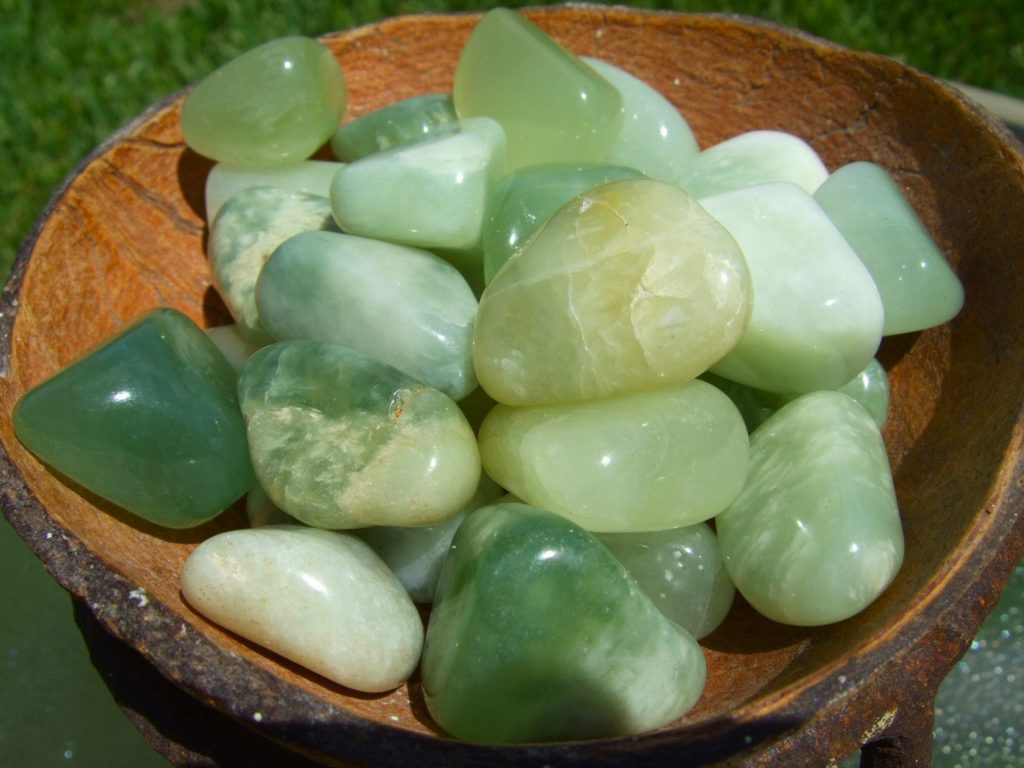
Jade is also a wonderful stone full of healing energy and a favorite to use alongside beauty regimes as it’s great for the skin and hair.
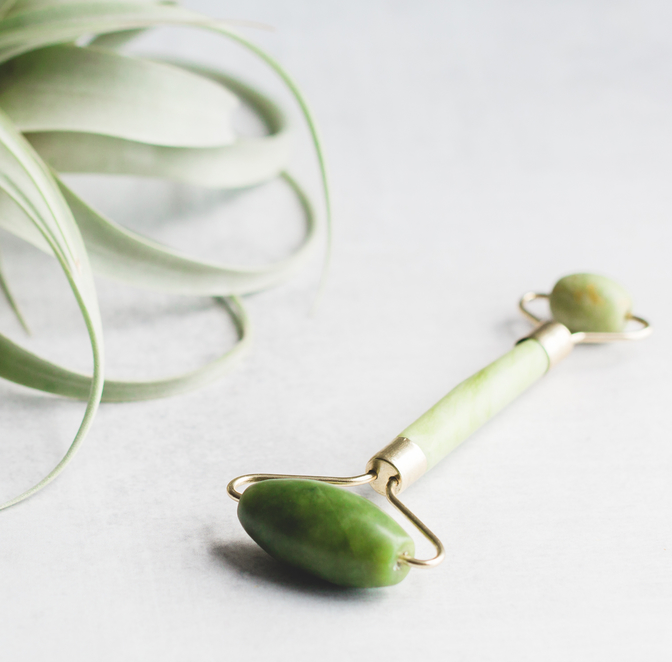
However, due to its HUGE popularity in Asia… we now have jade-fakes to contend with.
So, what to do?
Here are two quick ways to check if it’s the real deal …
- Look for the fibers. Fibers mean it’s real.
First thing to do is be sure you go shopping with a jeweler’s loupe (10x magnification is what I find to be the most useful for me) and look at the piece you’re considering purchasing under some natural sunlight or really good lighting.
What you’re looking for are little asbestos-like hairy fibers.
Sometimes chrysoprase is sold off as jade and it won’t have those little teeny fibers because of its microcrystalline structure making it look all the same with no fibers at all under the jeweler’s loupe.
- Temperature
Jade will be cold or cool to the touch and won’t warm up right away in your hand.
I’ll also be sharing some other easy to use methods to id a fake jade from the real thing in an upcoming live class! More on that below.
Red Malachite
I first heard of this one from one of my students early last year.
I was like, “huh”?
My confusions stemmed from my knowledge that malachite is a copper-derived stone and anything copper-derived will always be blue or green. Malachite is always a rich vibrant green color like these pieces here:
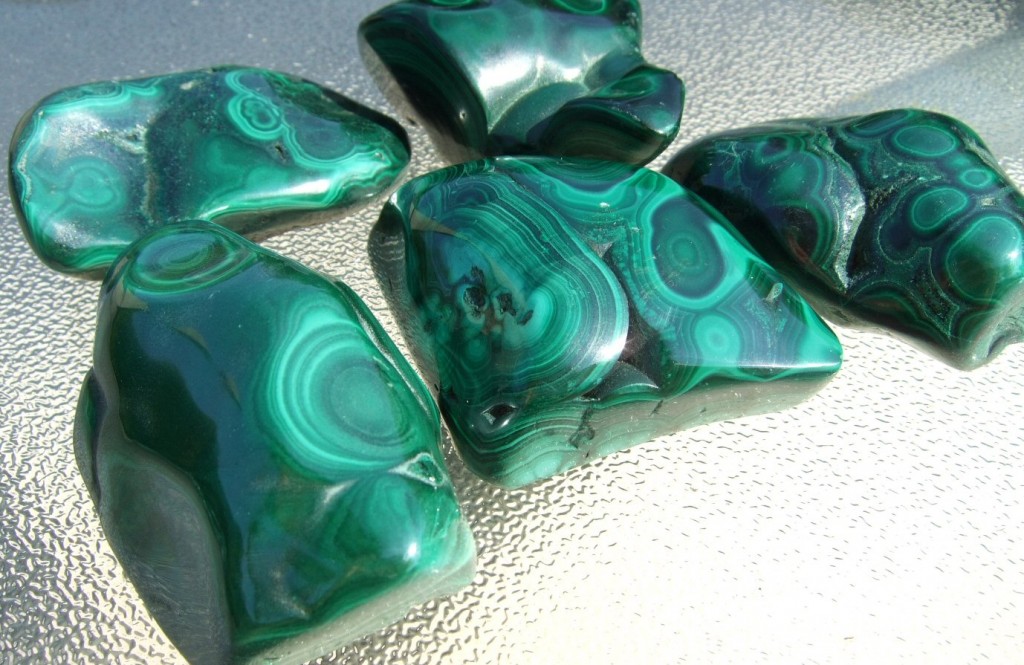
Smoothed & polished malachite
So, I knew something was up.
Then a few more students asked me again about this red “malachite” more recently.
This one really caught my curiosity. What is this stuff?! I had to know.
I got a hold of some and tested it out for myself.
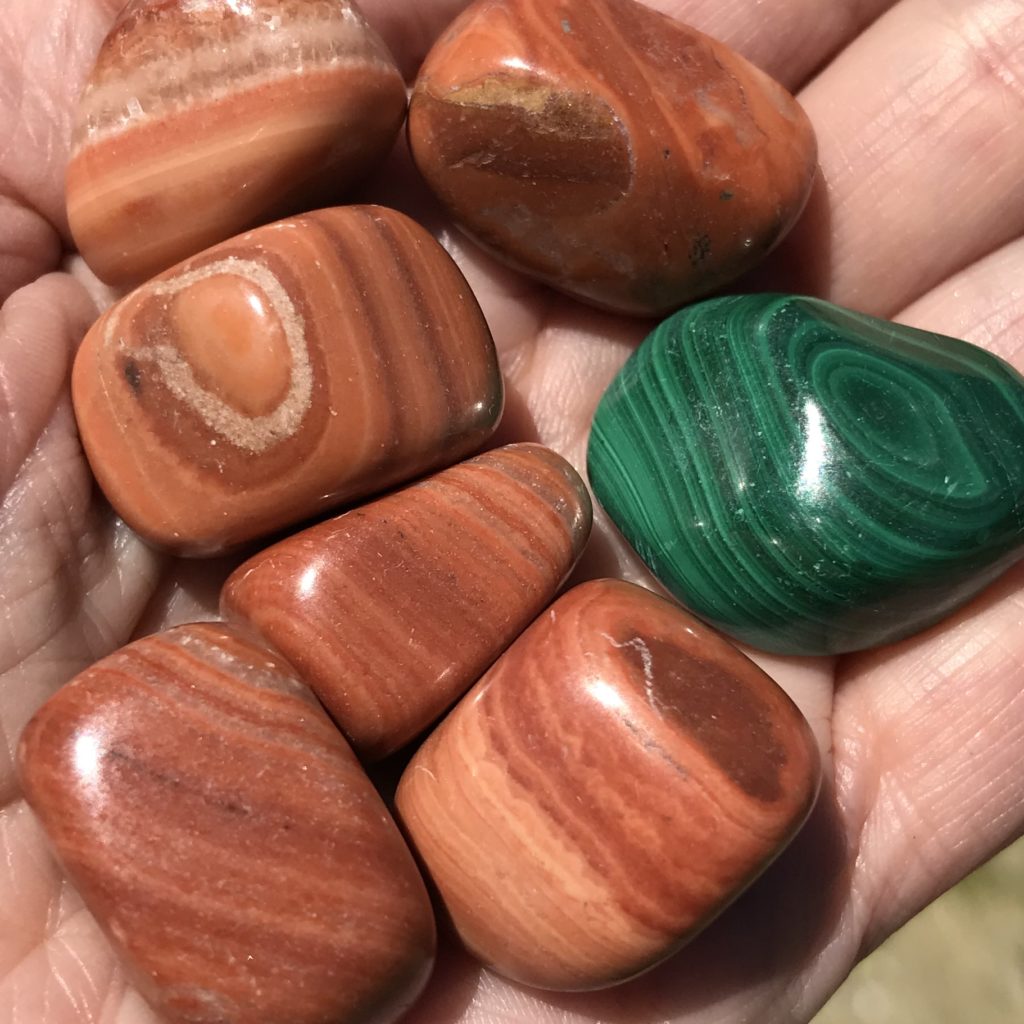
So I discovered it ain’t no jasper, agate or malachite. It’s a carbonate; probably a red travertine (limestone with calcite). I can show you how to do easy at-home tests like this yourself… more on that below.
Turns out “red malachite” is simply a new marketing term that some sellers have chosen to adopt in order to sell off some red-banded carbonate stones with no transparency. See, without the catchy new name this stuff used to just sit around. No one thought it was worth polishing/tumbling. Usually, this sort of stone would be considered “low-grade” material. :/
But, I actually think it’s quite pretty myself. It would probably sell just fine without the misleading name attached to it. What do you think?
When this kind of misinformation happens it ends up causing a lot of confusion in our crystal community. Not to mention falsely drives up prices.
So this “red malachite” has NOTHING to do with real malachite, not geologically and not energetically. Personally, I won’t be calling it “red malachite” (to try to eliminate confusion) but will call it as it is; red carbonate. It seems to have all the same energetic properties as, say, a red jasper; an ideal grounding and stabilizing root chakra stone that invites us to become physically stronger or more fearless. Good stuff!
Fake Opal
I’m not talking about opalite here as we’ve discussed that before.
Now we have yet another sort of fake-opal to concern ourselves with; a new synthetic sort that’s made to fool even the experts.
It looks very much like black precious opal.
Black precious opal is known for:
- its motivating quality
- ability to release psychic wounds
- ability to pull someone out of depression
The photo below is the real deal:
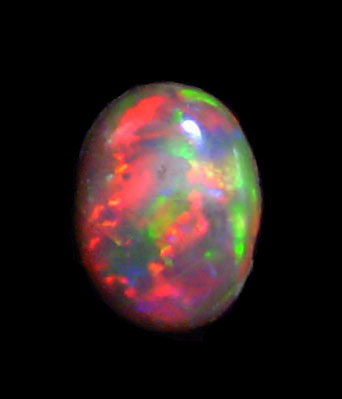
The color flashes and iridescence or “fire” in the fake stuff is what they call “non-directional”, meaning that it can be cut any which way while still maintaining the same exact flash of color. That’s just not the case with real opal.
This is what the synthetic opal looks like:
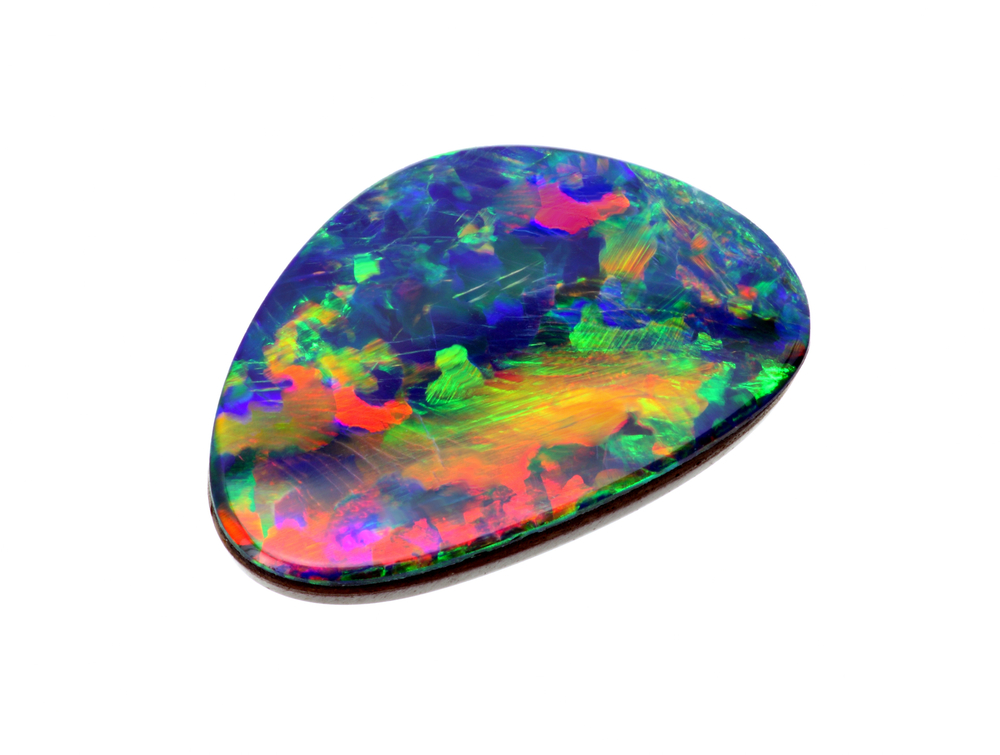
Unfortunately, I don’t have any handy tips for you to use to help ID this bad-boy. Black opal is expensive anyways so it’s always best to have an appraiser check out your opal for authenticity.
Frustrated?
Yeah. This fake stuff is starting to wear on me a bit too, but the good news is; the more informed we are as a community the less it’s going to affect us.
Please remember, I always say, if you choose to work with man-made crystals and you enjoy them that’s just fine and a name is just a name. You can call a stone anything you like. If it’s been working for you…“keep on ‘truckin’”. Don’t change a thing!
I just want all of us to have the geo-knowledge first. Then you can make an INFORMED decision regarding how you choose to use these stones in your practice.
And as always, the moral of the story here is…
Buyer Beware: Who are you buying from? Are they reputable? Do they know what they’re talking about? Are you doing your own due diligence and research? The best way to protect yourself is education.
If you didn’t already know this stuff, now you’re armed with a bit more information. 🙂 We all love the beautiful crystals and minerals that Mama Earth creates and the truth is, you don’t know what you don’t know… until you know it.
**Please SHARE this info with other Crystal Lovers so that we all stay in-the-know and well-informed. No duping us with FAKES!**
Have you seen any of these specimens I’ve mentioned here or any new fakes or misrepresentations recently? I’d love to hear in the comments below!
Now, again, if this topic rings your bell and you’d like to become confident in identifying fakes and misrepresentations in the marketplace then you might be interested in my Class- Crystal Savvy; Crystals + Mineral Identification.
Crystal Blessings,


Thanks so much! This is great info! I have noticed this with a few stones over the years, so its great to put this out for people to learn more! You rock!
TY Sweet Kelli!
Hi,
Can you do a post about Amber? I have seen many fakes and I believe I may have one, including people using plastic or resin to make an Amber ring. Any good way to tell the difference between the real thing and fake Amber?
Thanks!
Well…I support a healing store that I fully believed stocked genuine crystals. Recently I have experienced two things that lead me to question that.
One was a huge moldavite necklace that was sourced from their ‘reputable supplier’. I held this necklace and honestly felt very little from it which I thought was rather odd. The ‘moldavite’ also had numerous pieces of differing colours as I was left thinking maybe tektites but not moldavite. That was later made clear when I got hold of a small piece of moldavite from a miner and honestly had difficulties with the vibration and heat it produced.
The next issue is a Super 7 crystal that you indicate is a marketing ploy so explain why that crystal gave off massive energy. It was really powerful. There is also supposedly Super 7 that has red caps and marketed as Super 8 (from Brazil)…what do you know of that crystal?
I bought a skull on eBay. The seller calls it “coffee opal.” Apparently he’s the only one who uses the term. (If you search online, the only returns you’ll find are his eBay listings.) I’ve never been able to figure out if it really is a non-precious type of opal, or something completely unrelated to opal. Curiously enough, this skull is the ONLY stone I’ve had the SLIGHTEST kind of a “vibe” from. If I had to put a word to it, I’d say “industriousness.”
Hmmmm, I new one to look into. See, it looks like boulder opal sans the highly valued flash… so perhaps he found a new name to market it by. However, if you feel a pull towards it… its still opal. 😉
I had a ‘battle’ with a seller on Ebay.co.uk who was selling ‘amber’ skulls at a bargain price considering their size.The size and uniformity of the ‘amber’ set alarm bells ringing. I bought one even though I had my suspicions (but I liked it anyway). I tested it on the underside with a red hot pin and got a nasty smell of burning plastic. It took a good twelve messages between us for him finally to refund my money,claim that his supplier had misled him and say he would change the description to ‘Pressed amber’. He did too, although it was only one line in a rather florid description that ran to about thirty lines .,,,
Oh no, Pearl! And in no way is PLASTIC “pressed amber”. Wow. Glad you were persistent.
I had a similar problem with a stone. Everywhere I saw “Melody Stone”. Some call it a “Super 7” stone. In all actuality, it is Cacoxenite.It took me over a year to find that out.
Exactly, Sharon. I think Melody owns the land where this specific Cacoxenite is mined and has trademarked the name “Super Seven”.
The Super 7 crystal that you indicate is a marketing ploy so explain why that crystal gave off massive energy. It was really powerful. There is also supposedly Super 7 that has red caps and marketed as Super 8 (from Brazil)…what do you know of that crystal? If Melody Stone is Super 7 or Sacred Stone – Amethyst, Cacoxenite, Goethite, Lepidocrocite, Rutile, Smoky Quartz, and Quartz (which all the minerals are usually naturally encased in). Super 8 is all those with a red hematite on the crystal tips, it is often called Super-8 (containing the additional iron oxide). What do you know of that? Also known as Royal 8 or Harmonic Stone.
The ‘Super 7’ is a nickname in this industry but Cacoxenite isn’t the only mineral in it. It’s a combination of various minerals, hence the 7. So it’s not necessarily a fake, but the name is definitely made up for marketing.
Do you know anything about Super 8 or Royal 8 / Harmonic Stone? Super 7 certainly gives off a powerful vibration in my opinion. Marketing name or not Super 7 was not fake to me.
Thank you for the very informative articles. I have been trying to find a picture of a tumbled malachite from the inside, so I could compare some of the test pieces I have that were unfortunate to meet my hammer. I have two that look completely different, though both feel like real malachites to me. You wouldn’t happen to have a photo or a broken malachite? One of the malachites looks the same as on the outside, same stripe pattern and it sparkles very very lightly. The other one is FULL of sparkles on the inside, can’t see any stripes from under all that glimmer. It was sold by a European wholesale store as a grade A malachite. How do I know if it’s real? It feels heavy and cold and looks real to me, but I’ve never seen such glitter in a stone.
Sorry, no, Leo, but I’m sure if you go to a gem show and dig into the bottom of the bin of malachite, you’ll find lots of broken pieces there. Does this thread help you out at all?: https://www.reddit.com/r/Crystals/comments/7hq7jm/broken_malachite/
Oh the fake stuff drives me batty and every one is Gaga over them. Thanks for keeping us up to date!
My total pleasure, Dani! 😀
Thank you for always keeping us up to date! Very useful. 🙂
Available I have. Do you have the value of sale
Thank you for what you do, educating , inspiring and motivating on this spiritual plane. Do you have a list of reputable online stores, companies that ship, etc. to order from?
Thank you in advance for your assistance.
Hi,
Love all your crystal articles and information thereof, precious !!
I have a quick question, after reading your article on crystal fakes, I really wonder how and where to shop for authentic crystals these days. Do you sell crystals on your website ? If not, where do you generally buy ? These days we do most of the shopping online (at least I do), so getting something online means there is a 50 percent chance of being deceived. Which website or store would you recommend ? Would really appreciate your help, as I am just starting to explore this big world of crystals and would like to get a few basics from an authentic source.
Thank you,
Kalpita
Hello. ☺
To avoid fake stones I suggest museum stores or any stores/vendors that cater to the scientific community. (Full disclosure: I work in a museum store.) Selling fake minerals or giving them misleading names would be very bad for the museum’s reputation.
There’s also a good chance that you’ll save some money. For example, if there’s an amethyst with inclusions it’s usually just “amethyst” and goes under the same price code as the other amethysts of the same cost.
Even if you don’t buy anything you can become familiar with genuine stones by visiting museum exhibits or shops. You may even be able to touch/handle specimens. They may also have someone able to identify something you bring in or through emailed pictures.
There also could be a mineral an/or geological society near you. They may host small rock shows or offer educational resources.
In regards to the black opal/opalite. Are those the only 2 options?
The black opal is the “real” opal? The opalite is the “fake” opal?
Or the opal that looks similar to opalite is opal, and the one that look similar to black opal needs to be taken to a jeweler?
Thanks!
I have had troubles with clear quartz lately from several bead stores on etsy, they will magnify words on a book, look and feel like glass and do not have the weight they should. They will add fake black specs etc. To the points, faceted and smooth beads. Also so much fake turquoise that I stopped buying it.
I think the tip about buying from someone who is reputable would be more helpful if we could define what ‘reputable’ means in this market. I know of popular suppliers who have a ‘good reputation’, with a lot of unknowing customers, who sell fakes all the time. I find it especially annoying when suppliers rename a crystal that’s low on the MOHS as a crystal that is high. For example, calling blue calcite, onyx. *shudder* If consumers aren’t careful with that piece it can break. When people know the hardness they can do better at caring for their collections.
Oh my God, thank you!! This drives me crazy too!! And the blue calcite being sold as onyx is always the first example I think of! Girasol quartz being sold as opal is another. I know technically, girasol is opalized quartz (ie–it has a fairly high water content which gives it the glow) but it’s very misleading to many people to call it girasol opal or some of the many other nicknames some sellers want to give it.
Its bemusing the effort they put into making synthetic lab grown crystals Surely they could be inventing advancement s in medical science like growing prosthetic limbs and reconstituting bone marrow but fake jewellery which isn’t declared I the description is one of my peeves
Well, I do know that the black opal on the top, the real one is a jelly opal matrix and they do not have an identifiable matrix it is so fluid. However if you look at the opal on the bottom it does have an identifiable matrix which seems to move in all different directions. Usually crystals who have a matrix that is in every direction is usually due to some kind of quick heat and cooling anomaly. (similar to a man-made opal) A regular opal usually will take 5 or 6 million years to form. So if you see the pattern of the matrix going in all different directions it should be a clue that this is either extremely rare or fake. Opals have patterns that bring that can make the value of a stone higher. Starburst being the highest.
Hello, beautiful beings. I recently came across the debate of Cacoxenite being mislabeled Goethite in Super 7. Some say cacoxenite, a phosphate, cannot grow in the Brazil mines of super 7. I was looking for clarity on the matter & possibly a way to tell the difference between Goethite inclusions & Cacoxenite inclusions. I really, badly, want a cacoxenite piece, but I don’t want to buy something that isn’t truly cacoxenite…which is proving to be near impossible to find. Any info would be GREATLY APPRECIATED????????.
I bought a piece of malachite that has an almost “glittery” end on it. Would that be the other minerals showing through?